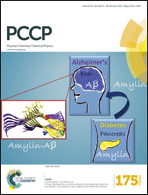X-ray absorption spectroscopy of lithium insertion and de-insertion in copper birnessite nanoparticle electrodes†
Abstract
The combination of ex situ X-ray diffraction (XRD) and X-ray absorption spectroscopy (XAS) measurements on 2D layered copper birnessite cathode materials for lithium ion battery applications provides detailed insight into both bulk-crystalline and localized atomic structural changes resulting from electrochemically driven lithium insertion and de-insertion. Copper birnessite electrodes that had been galvanostatically discharged and charged were measured with XRD to determine the accompanying long-range crystalline structure changes, while Mn and Cu K-edge XAS measurements provided a detailed view of the Mn and Cu oxidation state changes along with variations of the local neighboring atom environments around the Mn and Cu centers. While not detectable with XRD spectra, through XAS measurements it was determined that the copper ions (Cu2+) are reduced to form amorphous nano-sized Cu metal, and can be oxidized back to Cu2+. The reversible nature of the interconversion provides a rationale to the enhanced discharge capacity of copper birnessite relative to the analogous copper-free birnessite materials. The manganese oxide octahedra comprising the 2D layers in the original copper birnessite crystal structure disperse during lithium insertion, and revert back close to their original orientation after lithium de-insertion. During electrochemical oxidation or reduction the layered birnessite structure does not collapse, even though significant local disordering around Mn and Cu centers is directly observed.


 Please wait while we load your content...
Please wait while we load your content...